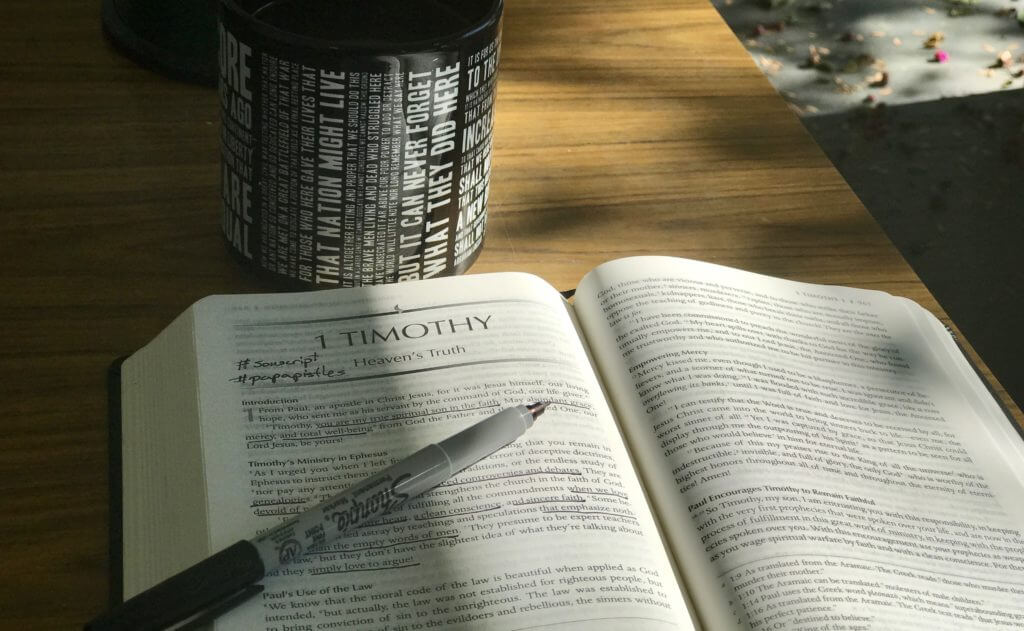
4 Steps to Help You Get the Most Out of Your Bible Reading
When I was going into high school, one of the youth group leaders at my church told us about how he approached Bible reading. He told us about REAP. (Read, Examine, Apply, Pray)
Over the years I have found myself going back the simple framework that he showed us to help provide some structure to my time in the Word. I am not sure who came up with the REAP acronym, but it has been helpful to me over the past 30 years.
READ – After I invite God to come reveal Himself to me the first step is to read whatever section of Scripture that I am going to be looking at. While this framework would work if you were only reading a verse or two, I usually find it best to read a little bit of a larger passage. That might mean a chapter, or a paragraph or two.
As you read through the passage the first time, just focus on the content. Try to practice active listening as you read. (I know that can be easy for me to tune out and let my mind wander on passages that I am familiar with.)
Take your time and read through the passage a few times if you need to. Remember, you are not getting points in heaven for getting through the Scripture. The goal is to get the Scriptures into you. Don’t move on to the next step until you have been able to read and understand the passage without distraction.
EXAMINE – Once you have had a good read through, now it is time to investigate what is taking place in the passage. You could use study notes or commentaries for this, but I would really encourage you to look at what you can learn from the passage itself.
Learning to DIG into the scriptures for yourself is important. In a day when the spirit of Google has replaced the spirit of wonder, it can be easy to turn to a search engine to find an answer instead of learning to look to the Word of God. If we only ever look at study notes or commentaries to help us understand what we are reading in the Bible, we can easily miss out on the dynamic of Holy Spirit speaking to us through His Word.
Study tools are not bad, in fact, they can definitely be a help to you. Just make sure not to miss out on the joy of discovering what God will reveal to you as you take time to look.
WHAT DOES THIS LOOK LIKE?
For me, the EXAMINE step comes down to taking time to answer a few questions about what I am reading. There is no formula or perfect set of questions that you have to answer. After all, spending time reading the Bible is not just a way to learn and process information. The Word of God is alive and the Holy Spirit breathed every word.
The act of examining the Scriptures honors God and the treasure that He has given to us in His Word. When this is done in humility, it attracts His grace to your life. With that being said, here are a few of the questions that I often use to EXAMINE a Bible passage.
-
WHO wrote this passage? This will help you understand the perspective / voice behind the passage. While the scriptures are inspired by God, He chose real people with real stories and different experiences and perspectives to write them. For example, understanding that the Gospel of John and 1 John were written by the same man can provide valuable insight into your reading. When you remember that it was John that was leaning up against Jesus at the last supper, suddenly, the introduction of 1 John takes on a different meaning: That which was from the beginning, which we have heard, which we have seen with our eyes, which we have looked upon, and our hands have handled, concerning the Word of life.
-
WHO is this passage written to? Knowing the audience that a passage was written to is one of the most helpful ways to understand the context of the passage itself. Knowing that the book of Psalms is a actually a book of songs helps us understand why the progression from chapter to chapter is so different than the way the book of Isaiah is written. You can usually learn a lot about the audience at the beginning of each book. (Especially the NT) This is one reason why it is good to read entire books of the Bible. You will gain valuable insight about WHAT is written by understanding WHO it is written to. For example, the book of James was written to the twelve tribes scattered abroad. The value of what James writes in his letter about hardships, the wisdom of God, and how we treat each other will take on new meaning when we remember that he is writing to people who are living in exile. This context helps us understand how rich the Word is, and how costly it can be to live it out.
-
WHAT is the main thought in the passage? Once we have investigated and found out who the letter is from and who it is to, we move on to investigating the contents of the passage itself. What does the scripture say? Sometimes the WHAT of a passage can be found in just a few, short words. Other times it can be a thought that is unpacked through several paragraphs. Again, it is important to take the time to look and see what is happening in what you are reading, instead of just getting through it. Understanding the main idea of a passage will help you be confident as you put the Word that you are reading into practice.
-
WHAT words, thoughts or ideas stand out to me in the passage? This is one of my favorite questions to ask when reading Scriptures because the Bible is not just static information – it is alive and powerful. After you have a good grasp on the big idea of what you are reading, look to see if there is anything specific that stands out to you. You could read and examine the same passage 100 times and never stop learning. Asking Holy Spirit to highlight certain parts of the passage to you is one of the most practical ways to learn how to hear His voice and grow in your relationship with God. You might find that in your time in the Word, the Lord is ministering to a hurting place, answering a question, or bringing correction. When you have a good understanding of the big idea of the passage, it gives a structure for God to speak to you in ways that are more specific. The specific things that God is highlighting will fit inside of the meaning of the main idea of the passage. Remembering this will allow you to be confident that you have a good understanding of what God is speaking to you through His Word.





